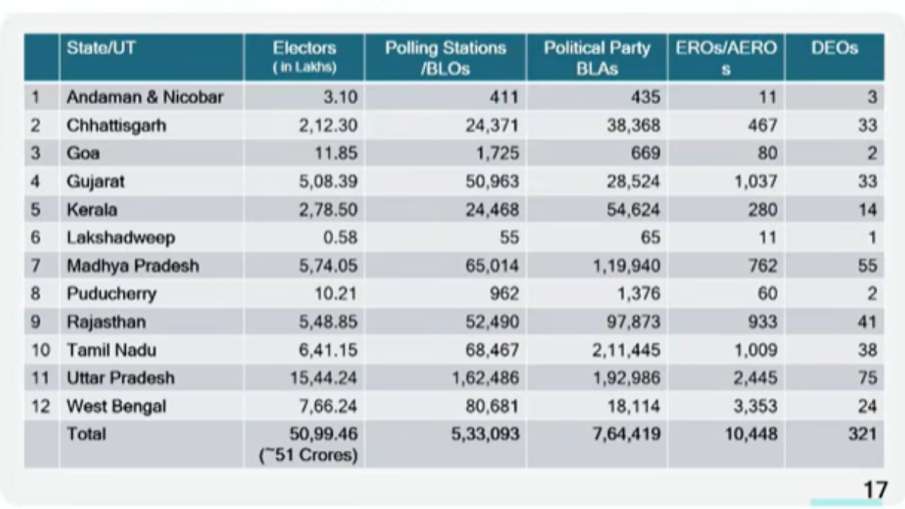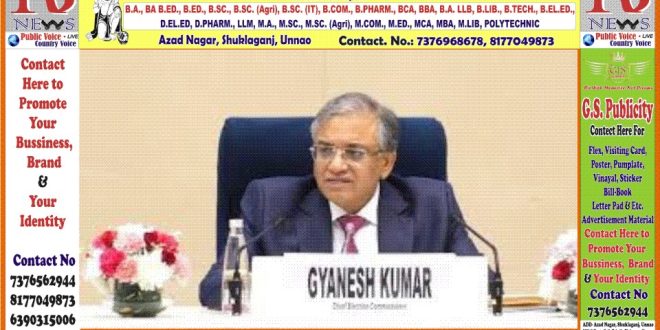Following Bihar, the process of Special Intensive Revision has begun in nine states and three union territories. Chief Election Commissioner Gyanesh Kumar stated that the objective of this process is to include eligible voters in the list and remove ineligible voters from the electoral rolls. The Chief Election Commissioner explained that the last Special Intensive Revision in the country was conducted 21 years ago, making it essential to purify the electoral rolls. The Election Commissioner stated that BLOs will visit every household three times. During this time, they will meet with voters to confirm their names on the list and provide them with voter inclusion forms. Those who live outside their homes or attend office during the day will be able to add their names online.
Voters will not need to submit any documents in the first phase of enlisting. They will only need to indicate whether their name appeared in the 2003 electoral rolls and, if their name was missing, whether their parents’ names were included. The 2003 electoral rolls for all states can be viewed on the Election Commission’s website.
The number of polling booths will also change.
The Election Commissioner clarified that no booth can now have more than 1,000 voters. Therefore, the number of polling booths will also change after the Special Intensive Revision (SIR) to avoid crowding of voters. The 12 states where SIR is to be conducted have a total of 510 million voters.
A separate announcement will be made for SIR in Assam.
Chief Election Commissioner Gyanesh Kumar said, “The Citizenship Act of India has separate provisions for Assam. The citizenship verification there is about to be completed under the supervision of the Supreme Court. The 24th SIR order was for the entire country. As such, it does not apply to Assam. Therefore, a separate amendment order will be issued for Assam.”
states / union territories. |
Voters (in lakhs) |
| Andaman and Nicobar |
3.10
|
| Chhattisgarh |
212.30
|
| Goa |
11.85
|
| Gujrat |
508.39
|
| Keral |
278.50
|
| Lakshdweep |
0.58
|
|
Madhya Pradesh
|
574.05
|
|
Puduchery
|
10.21
|
|
Rajasthan
|
548.85
|
|
Tamilnadu
|
641.15
|
|
Uttar Pradesh
|
1544.24
|
|
West Bengal
|
766.24
|
|
Total
|
5099.46 (51 Crore)
|
Key dates for the second phase of SIR
October 28: The second phase of the Special Intensive Revision begins.
November 4: BLOs will go door-to-door to distribute forms and prepare a new voter list by linking it to the 2003 list. This process will continue until December 4.
December 9: The draft voter roll will be released. Those whose names are not linked will be sent a notice, and their names will be added to the list upon production of documents. People will have the opportunity to appeal until January 8. The process of document verification and adding names to the list will continue until January 31.
February 7: The final voter list will be released.
What is the process?
The SIR process will be conducted in three phases. In the first phase, voters’ names will be linked to the 2003 voter list. Voters will simply need to indicate where their or their parents’ names appeared in the 2003 voter list.
Those whose names cannot be linked to the 2003 voter list will be added in the second phase. In this phase, the Election Commission will issue notices to those whose names have not been linked. Voters will be required to provide relevant documents. Aadhaar cards will also be accepted. They will also be required to provide details of their and their parents’ locations in 2003. After this, the provisional list will be released.
With the release of the provisional list, voters will have the right to appeal. During this phase, those whose names were not included in the list even in the second phase will be able to appeal. Additionally, those with discrepancies in their names or other information will also be able to have their information amended.
 RB News World Latest News
RB News World Latest News






